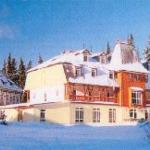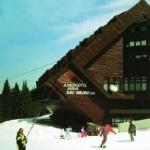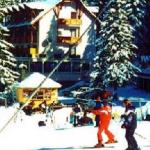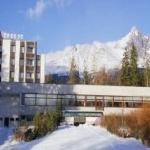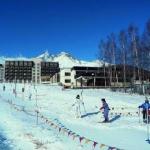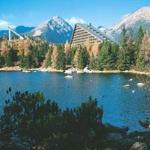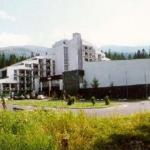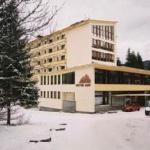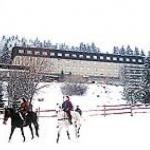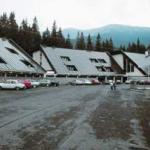Slovakia Sights
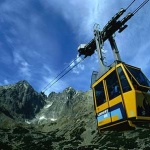 Slovakia, despite its modest size, can boast an abundance of natural beauty and wonderful opportunities for recreation. Known throughout Europe Small mountain ranges and the White Carpathians, the Tatras, Mala Fatra, the Ore Mountains, and are supplemented here Javorníky abundance of karst areas, caves, hot springs and vast forest areas, and the ancient cities of the country are of undoubted interest to lovers of history. Travel the country's capacity is very high and not yet sufficiently appreciated - in winter it is one of the best ski resorts in Eastern Europe in the summer - a beautiful historic district, besides having all the opportunities for recreation, and more than 1 400 mineral springs of the country to allow therapeutic procedures in any time of year. Across the country, are about 180 of medieval castles, among which the most interesting castles Spišská Castle, Orava (30 km. North of Ruzomberok), Zborov, Trencin, Bratislava Castle, Devin, Kezmarok, Kremnica Zvolen, Smolenice, Červený Stone (near from the town of Modra) as well as the ruins of the fortress and castle Levin Beckov far from Bratislava.
Slovakia, despite its modest size, can boast an abundance of natural beauty and wonderful opportunities for recreation. Known throughout Europe Small mountain ranges and the White Carpathians, the Tatras, Mala Fatra, the Ore Mountains, and are supplemented here Javorníky abundance of karst areas, caves, hot springs and vast forest areas, and the ancient cities of the country are of undoubted interest to lovers of history. Travel the country's capacity is very high and not yet sufficiently appreciated - in winter it is one of the best ski resorts in Eastern Europe in the summer - a beautiful historic district, besides having all the opportunities for recreation, and more than 1 400 mineral springs of the country to allow therapeutic procedures in any time of year. Across the country, are about 180 of medieval castles, among which the most interesting castles Spišská Castle, Orava (30 km. North of Ruzomberok), Zborov, Trencin, Bratislava Castle, Devin, Kezmarok, Kremnica Zvolen, Smolenice, Červený Stone (near from the town of Modra) as well as the ruins of the fortress and castle Levin Beckov far from Bratislava.Bratislava - one of the most interesting, historically, the cities of Eastern Europe. Located in the picturesque spurs of the Carpathians, near the border with Austria, it was founded in 907 and is known as a city since 1291, and from 1541 was even the capital of Hungary. The town is small enough, so all the major sights are compact and can be avoided even by foot. The most interesting old Radnitsa (Old Town, XIII cent.), The Primate's Palace (1778-1781 gg.) With the famous Hall of Mirrors and a fountain in St. George, the place of the coronation of many Hungarian kings - St. Martin's Cathedral (XIV-XV cc.) Reduta Palace (1914, now here is the Bratislava concert hall), Grassalkovich Palace (1760.) Main Square ( "Home náměstí) with a fountain of Roland (1572), the Franciscan church (1297), opposite the Palace Mirbach ( 1770), the Church of the Holy Trinity (1725), the former building of the Hungarian Parliament - Royal House (1756), the royal castle Bratislava (Bratislava Castle, IX-XIX cc.), the Presidential Palace (XVII century.) mansion Segnera (XVII century.), picturesque streets Zamoska, Žižkov, Kapitulska, Klariska, Laurinska and Panska, the building of the Slovak National Theater (1886), garden Janko Král, etc.
Attractive capital's museums - the Slovak National Gallery, the Municipal Museum in the old Town Hall, Pharmaceutical Museum, the Museum of Folk Music, a music museum Hummel in the house this composer, the Museum of Wine, a tower of Michael with a collection of ancient weapons, the Museum of Decorative Arts, the Archaeological Museum, Historical Museum, Museum of the non-European cultures, the Museum of Jewish Culture, the Museum of Carpathian German Culture, Bratislava City Museum, Zoo, etc. And, naturally, in a wide variety of restaurants and cafes, bars and cellars, and wine (Vinarov), beer ( " pivaren ") and coffee (" kaviaren ") establishments for every taste, as well as discos, cinemas and music sites.
In the outskirts of the capital attracted a wide range of Devin Castle (10 km. West of the capital), a national monument of nature and culture, as well as antique Gerulata in Rusovtse, lake resort Zlaté Piesky (7 km. North-east of Bratislava), the famous wine Malokarpatská region to the east of the capital - Vajnory, Racha (included in the capital), Frankovka, Holy Ure, Slovenian Coffin, Pezinok, Modra and others, forming the famous "wine road". 50 km. east of the capital lies the old Slavonic fortified settlement Nitra, famous for its castle, the Franciscan church and monastery, as well as the Palace (XVIII cent.), Colonnade (XVIII cent.) and an extensive library of the abbey in the "Old Seminary" (XVIII cent.).
To the south-east of the capital, in the south of Slovakia, lies the town of Komarno - Center of the Hungarian community of the country. In this city interested in the old fortifications (XIV-XVIII cc.) Church of St. Andrew (1734), a picturesque bridge over the Danube (1892), Museum of the Danube with a good historical and art collections, The Town Hall (1875 ), the Serbian Orthodox Church (XVIII century.) & Museum Lehar and Jokai. 50 km. to the north-east of Bratislava, Trnava is famous, "Slovak Rome" as it is often called because of the location here Trnava archdiocese, university buildings (XVII-XVIII cc.) and the picturesque Old Town.
West Slovakia - the land of mountains and forests, fast rivers and narrow river valleys. One of the most attractive cities in the region - Trencin, located on the site of a Roman camp Laugaritsio. Here it is interesting to visit the main square Mierove náměstí, church and city gates (XVI cent.), An art gallery in the building of the nunnery, the parish church (XVI cent.), The majestic Castle Trencin (1069), "The Well of Love" depth of 70 m. to inspect the famous Roman inscription of the victory of the 2 nd of the Roman legions of Germanic tribes (179 AD. e.) and the Museum of Trencin. At 14 km. to the north-east of the resort located Trenchanske Trencin Teplice, famous for its baths, hammam "in the Moorish Revival (1888) and therapeutic hot sulfur springs.
Lesser Fatra Mountains stretch for hundreds of kilometers across the north-western Slovakia, forming an extensive self-titled National Park. Home "pearl" here - a beautiful valley Vratna, renowned for its rocky cliffs, forested slopes, numerous ski resorts and hundreds of hiking trails on the most picturesque places. To the west of the spurs of the Little Fatra mountains, 80 km. of Trencin, is the third largest city in Slovakia - Zilina, whose foundation dates back to XIII century. City, often being named as the "Gateway Fatra, draws its provincial appearance, striking at rest (and this is the major transport hub!), As well as its picturesque main square Mariánské náměstí with a picturesque church and its envelope covered gallery, the Museum of Zilina in the castle of XVI century and many original restaurants and shops.
Central and eastern parts of the country is a crossroads of ancient trade routes and excellent place for active recreation. The capital of the eastern Slovak city of Kosice is - the second largest city in Slovakia. Imprints of the rich history of the city are visible at almost every step. Beyond the walls of the Old Town has many unique historical monuments - one of the most beautiful Gothic churches of the world - the Cathedral of St. Elizabeth (1345-1508 gg.) With the tomb of Ferenc Rákóczi, City Theater (1899) with a musical fountain at the entrance, an old town hall (1780), "House of the Košice Program (here in 1945, was proclaimed the program of the Popular Front, is now an art gallery), Urban's Tower (XVI century., now a museum of metal jewelry), the Church of St. Michael ( XIV century.) Plague Column (1723), picturesque streets of the major, the old prison "Miklusova Vazhnitsa" (XVI cent.), a great old three-story building, the hotel Europe, etc. Interesting Slovak Technical Museum, the Museum of Eastern Slovakia (1912 g.) with a cozy park behind the building of the museum and the old wooden church, the Zoological Museum in Bastion executioners, State Theater, as well as the Hungarian theater "Waist" and the State Philharmonic.
At 36 km. north of Kosice Presov is known for its Gothic St. Nicholas Church (XIV century.) Evangelical Church (1642), the Museum Wine Museum Presov and with good collections of archaeological and natural history. Another medieval town, the eastern borders "- Bardejov, lies to the north of Presov. Here is look at the parish church of St. Egidijus (XIV-XV cc.), The old Town Hall (1509, now a museum), as well as the Historical Museum and the Museum of icons. 6 km. north of Bardeeva is Bardeevske-font, one of the finest water resorts in Slovakia, where the end of XVIII century. local mineral waters from 8 different sources treat illnesses of the digestive tract and lungs. Also here is the best and Slovak Ethnographic Open Air Museum - Šariš.
Poprad - a modern industrial center, not very interesting from a tourist point of view, but frequented by many, because there is an international airport Poprad-Tatry. But around the city is located a great variety of resorts and sports centers, and nearby tracts of the High Tatras and the Slovenian Raya literally full of the beauties of nature. National Park Slovenian Paradise, which lies south-east of the city Spisska Nova Ves, established in 1988 and allows you to get acquainted with the beauties of the valley of the river Hornád. Tatra National Park (TANAP, the first national park, which was established in the former Czechoslovakia, 888 sq. Km.) Forming a unit with a similar park in Poland that is considered one of the best centers of active leisure in Europe. It laid 600-kilometer network of well marked walking trails, connecting all the alpine valleys and many peaks. Here, in the vicinity of the park, there are such famous resorts as Stari Smokovec, Strbske Pleso, Tatranska Lomnica-known center of maritime tourism - the valley of the river Dunajec, XIV century Carthusian monastery, etc.
Levoca (26 km. From Poprad), founded in XIII century., Famous for its medieval walls (XV cent.), A network of old narrow streets, its churches, St. James (XV cent.), Marianske Mount (XVI century.) minoritskoy (1750) and Evangelical (1837), as well as the Museum of Spis region in the building of the old Town Hall, Art galleries, museums and beautiful master Paul's central square. Between Poprad and Presov is complex fortified abbey in Spišská Capitulum (XIII cent.) Attracting its medieval castle gates, picturesque houses along a single street and a magnificent cathedral of St. Martin (1273). Nearby is also the largest medieval castle of the country - Spišská Castle (XIII-XV cc.).
Located in central Slovakia, in the southern spur of the Low Tatras, Banska Bystrica included in the list of World Cultural Heritage by UNESCO. This old mining town (first mentioned in 1255) is interesting for its medieval buildings, such as the castle church (XIII-XIV centuries.) Church of the Holy Cross (XV cent.), Old Castle (1548), and Mountain Building Forest Academy, as well as numerous medieval houses in the German style. Not far from Banská Bystrica is one of the largest winter sports centers of the country - Donovaly.
No less colorful and lying far south of the city of Banská Schtyavnitse, famous for its luxurious Geological Museum, the old houses and monuments of the mining industry. And lying between the two towns Zvolen should necessarily pay attention to the castle of Louis the Great (1370-1382 gg.).
One of the main attractions of Slovakia - the numerous mineral springs and caves. Only in Bratislava, there are more than a dozen caves, and across the country they are about 4 thousand, and examined under a quarter of them. The most interesting Demänovská cave system (Cave of Freedom, ice caves, etc.) in the homonymous valley on the north side of the Low Tatras, Belianska caves near-Tatranska Lomnica, Bistryanskie and Harmanechskie cave near Banska Bystrica, a cave Vazhechka in Liptovsky Mikulas, Dobšinská Ice Cave in the national reserve Stratena included in the list of UNESCO World Heritage caves Gombashechska, Jasovská, Domica and unique Ochtinskaya aragonite cave not far from Kosice, Drina cave near Smolenice, etc.
